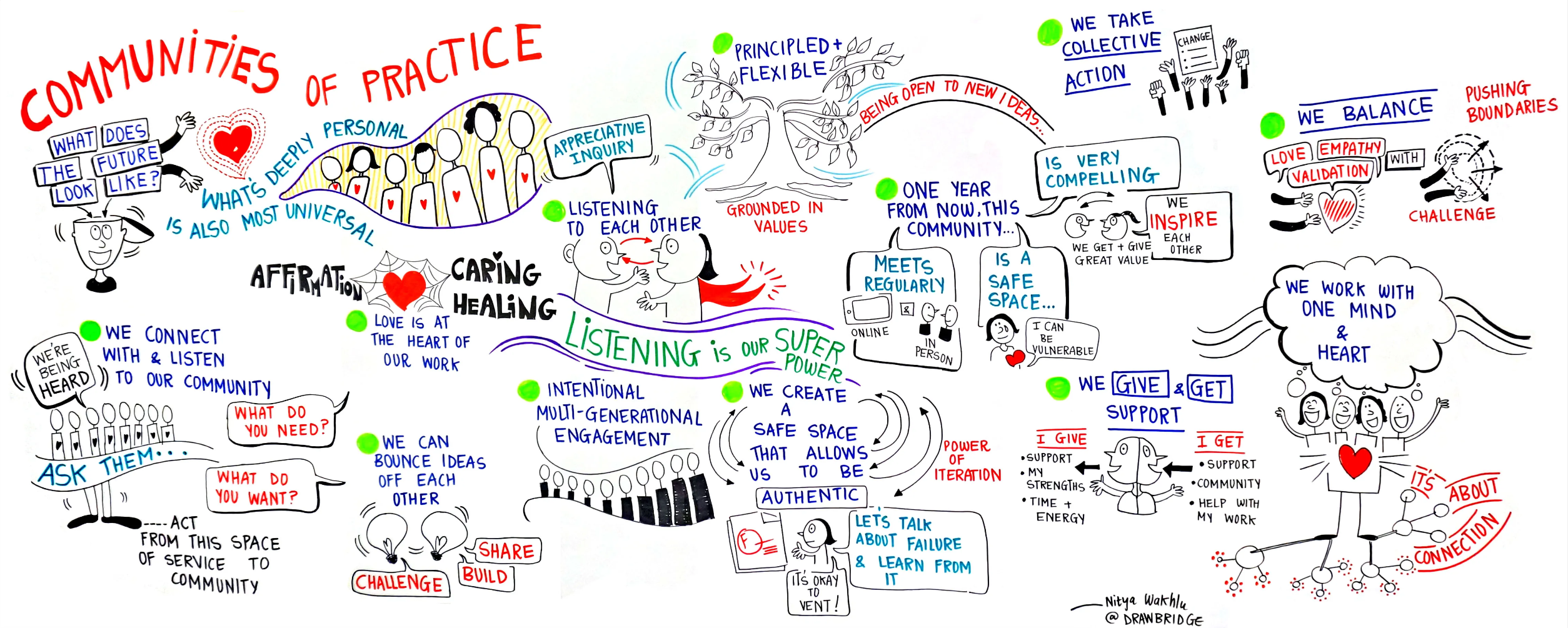
Image Credit: Nitya Wakhlu
“Practice does not exist in the abstract. It exists because people are engaged in actions whose meanings they negotiate with one another.” (Wenger 1999: 74). Therefore, as creative practitioners, we join communities to aid our personal development to drive innovation. However, communities of practice are not just defined by location or who knows who. Instead, they are characterised by engagement. (Wenger 1999). Being a member of a community of practice requires work, but that may include invisible work such as squirrelling out the latest gossip or providing snacks at the latest community get-together (Wenger 1999). The tacit knowledge gained by participation in all aspects of a community is vital, as casual conversations provide metaphors or new situations in which we can cement our knowledge (Parker 2023).
Gaining explicit knowledge through lectures, books and every other source out there is something I have always found easy. If I am interested in a topic, I seek out all the information, absorbing it like a dry sponge thrown into a swimming pool. However, tacit knowledge is something I have never understood. More often than not, I put my foot in it because I miss the subtleties and do something stupid. But over the years, I am learning to be more relaxed in social situations and by lowering my stress levels, I have found it easier to notice and absorb community ‘rules’.
By comparing my life experiences with various communities and the theoretical research of Wenger regarding learning communities, I see now that I never fully understood the importance of existing social structures. What I have sometimes viewed as arbitrary, I realise now, is (usually) etiquette that has developed naturally throughout the community’s existence. From now on, when I aim to join a new community, I will adjust my behaviour to listen first and talk second. In many of my previous forays into professional communities, non-stop panic talking was my default. Unsurprisingly, that tactic doesn’t get you far.
Participating in the weekly challenges helped me come to these conclusions. Task one was to discuss our networking experiences at conferences, while task two was to write a short ethnographic report on a community I am part of. Despite my initial confusion about the relevance of these tasks, I nevertheless found them rewarding. Simply writing out what I did at a conference, why I went and what I didn’t like made it suddenly clear how I should approach conferences in the future. That might even be not going to them at all or seeking out specific attendees beforehand and connecting with them during the event. Conducting a quick ethnographic study also helped me to understand that, at face value, some rules might seem arbitrary. It is only when considering that community’s history that they make sense.
Moving forwards, I want to join the UX Wizards, a casual get-together of designers and developers in Zürich (Raess 2017). It is a monthly gathering of UX professionals intended to grow the local community outside the professional environment. Additionally, within the professional sphere, I will attend the next Ginetta Tonic Festival and Interaction24 conference. Knowing that I am an introvert, I will join these communities in a way that is true to myself and my needs. Li (2019) recommends embracing the one-on-one technique of engaging with people individually first to build a relationship, while Gonzalez (2020) espouses the benefits of setting up an ‘introvert-friendly corner’.
The community that has developed as part of this MA is quickly becoming integral to my support network while studying. Throughout the week, we keep up to date with each other and share resources through the university forums and our discord server. As we progress into other modules, I will endeavour to keep up with our small discord group and engage in the wider Falmouth UX server.
Researching communities of practice has helped me realise something else basic but vital. Our aim shouldn’t be to ‘get good’ at something but to focus on always getting better. Only by joining communities and sharing our work or experiences, asking for help and giving feedback can we begin to grow holistically. After all, “there is a pleasure in improving your abilities even if that doesn’t translate into actual perfection.” (Shirky 2010: 245)
References
GONZALEZ, Dioselin. 2020. ‘I Am an Introvert. This Is How I Network.’ [Medium]. The Startup [online]. Available at: https://medium.com/swlh/i-am-an-introvert-this-is-how-i-network-8523f7115a97 [accessed 1 Apr 2023].
LI, Jessica. 2019. ‘How I Learned to Love Networking as an Introvert’. Forbes [online]. Available at: https://www.forbes.com/sites/ellevate/2019/10/07/how-i-learned-to-love-networking-as-an-introvert/ [accessed 1 Apr 2023].
PARKER, Alcwyn. 2023. ‘Communities of Practice’. Available at: https://learn.falmouth.ac.uk/courses/483/pages/week-9-researching-communities-of-practice?module_item_id=29832 [accessed 1 Apr 2023].
RAESS, Simon. 2017. ‘UX WIZARDS’. meetup [online]. Available at: https://www.meetup.com/uxhappyhour/photos/ [accessed 1 Apr 2023].
SHIRKY, Clay. 2010. ‘Publish, Then Filter’. In Helen DONELAN, Karen Lesley KEAR, and Magnus RAMAGE (eds.). Online Communication and Collaboration: A Reader. Routledge, 236–50. Available at: https://archive.org/details/onlinecommunicat0000unse/page/n5/mode/2up [accessed 2 Apr 2023].
WENGER, Etienne. 1999. Communities of Practice: Learning, Meaning, and Identity. 2004 Reprint. Cambridge University Press.
German vocabulary of the week
Community – Gemeinschaft
